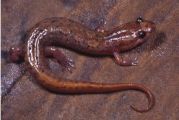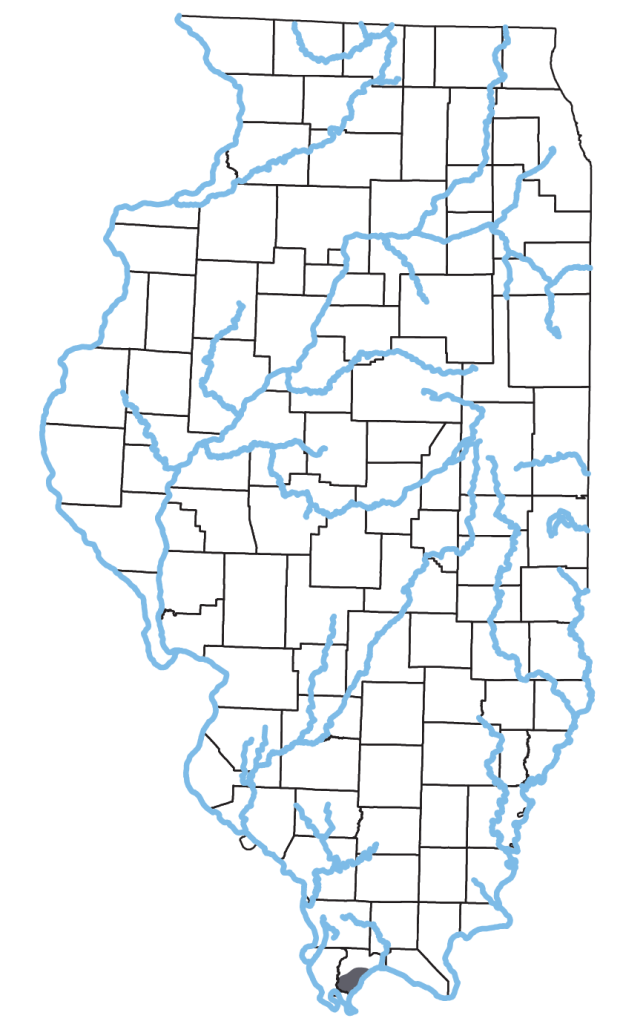Desmognathus conanti (Rossman, 1958)

Key Characters: Nasolabial grooves present; pale diagonal line from eye to angle of jaw.
Similar Species: Four-toed Salamander, Small-mouthed Salamander, Southern Two-lined Salamander. See Key to Adult and Larval Salamanders of Illinois for help with identification.
Subspecies: None currently recognized.

Description: A moderately stout (up to 12 cm TL) salamander with dark markings on back, remnants of spotted juvenile pattern, that form a broad, irregular light stripe down back and onto tail. Light belly is mottled with black and light flecks. Male has enlarged jaw muscles during spring/summer breeding season. Larva with short, glistening-white gills, and 5-8 pairs of light spots on back.

Habitat: Cool, spring-fed headwater streams flowing through forests. Larvae are found in streams and spring seeps.
Natural History: Adults are mainly nocturnal, moving about on stream banks at night. During the day they take refuge in burrows or under logs, rocks, and leaves at edge of the stream. Adults eat a variety of invertebrates and occasionally their own larvae. The tail is easily broken; many adults have short or regenerated tails as evidence of escape from predators. Mating occurs from April through July. The female curls around and guards her eggs, which are laid in a burrow, moss, or depression under log, rock, or leaves near water. Larvae hatch in autumn and wriggle into water, where they feed and grow until transforming the following spring.
Distribution Notes: Occurs only in isolated populations in Pulaski County where the Porter’s Creek formation of absorbent clay is found near the surface, and one (probably an introduction) in Johnson County. Most populations are found in direct tributaries to the Ohio River in ravines where the Porter’s Creek clay has been exposed by downcutting of streams. A few populations exist just over the divide in the Cache River drainage of northern Pulaski County.
Status: Mining of the absorbent clay for kitty litter and other absorbents threatens some populations. Endangered in Illinois.
Etymology: Desmognathus – desmos (Greek) bond, ligament; gnathos (Greek) jaw; conanti (New Latin) – “Named for Roger Conant, Zoological Society of Philadelphia in recognition of his contributions to herpetology”.
Original Description: Rossman, D.A. 1958. A new race of Desmognathus fuscus from the south-central United States. Herpetologica 14:158-160.
Type Specimen: Holotype, ANMH 62223; Douglas A. Rossman and Nita Jane Rossman, collector; July 28, 1957.
Type Locality: “400 ft. el., near U.S. Highway 60, 2.1 mi. S. Smithland, Livingston Co, Ky”
Original Name: Desmognathus fuscus conanti Rossman, 1958
Nomenclatural History: Originally named as a subspecies of D. fuscus and later elevated to full species by Titus & Larson (1996, Syst. Biol., 45: 451-472). More recent molecular-based studies have reaffirmed the specific status of D. conanti (see Beamer and Lamb, 2008, Mol. Phylogenet. Evol. 47:143-153).
Other Illinois Literature
Bonett, R.M. and J. D. McEachran. 2002. Analysis of the contact zone between the dusky salamanders Desmognathus fuscus fuscus and Desmognathus fuscus conanti (Caudata: Plethodontidae). Copeia 2002(2):344-355.
Brandon, R.A. & J.E. Huheey. 1972. Distribution of the dusky salamander, Desmognathus fuscus, in Illinois. Chicago Academy of Sciences Natural History Miscellanea 205. 7pp.
Dyer, W.G. 1986. First record of Phyllodistomum solidum Rankin 1937 (Trematoda: Gorgoderidae) in the dusky salamander (Desmognathus fuscus) form southern Illinois. Transactions of the Illinois State Academy of Scence 79:291-292.
Dyer, W. G., R.A. Brandon, and R.L. Price. 1987. Gastrointestinal helminths in relation to sex and age of Desmognathus fuscus (Green, 1818) from Illinois. Proceedings of the Helminthological Society of Washington 47(1):95-99.
Karlin, A.A. & S.I. Guttman. 1986. Systematics and geographic isozyme variations in the plethodontid salamander Desmognathus fuscus (Rafinesque). Herpetologica 42(3):283-301.
Karlin, A.A., S.I. Guttman & L.R Stephen. 1984. Spatial autocorrelation analysis of heterozygosity and geographic distribution in populations of Desmognathus fuscus (Amphibia: Plethodontidae). Copeia 1984(2):343-346.


